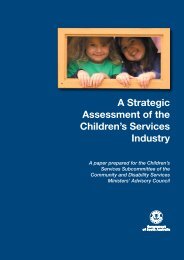Global Study On Child Poverty And Disparities (PDF) - Social Policy ...
Global Study On Child Poverty And Disparities (PDF) - Social Policy ...
Global Study On Child Poverty And Disparities (PDF) - Social Policy ...
You also want an ePaper? Increase the reach of your titles
YUMPU automatically turns print PDFs into web optimized ePapers that Google loves.
As noted above, access to health care is not evenly distributed, and access to hospitals in particular<br />
is far greater for those living in urban areas. The two referral hospitals are in Port Vila and Luganville.<br />
Vanuatu’s ratio of 2.16 beds per 1,000 population is higher than that of many other PICs.<br />
Table 3.6: Health infrastructure, 2008<br />
Public health facility Number of facilities Number of beds<br />
Tertiary hospitals 2 374<br />
Provincial hospitals 3 443<br />
Specialised hospitals 2 146<br />
Health centres 32 376<br />
Primary health care centres 89 0<br />
Village-based air posts 180 0<br />
Source: ADB 2009b, Table 5.1.<br />
In 2005, Ministry of Health financing accounted for<br />
61 per cent of total financing of health in Vanuatu.<br />
Private households contributing 18 per cent and<br />
donors 16 per cent, and other sources accounting<br />
for the remaining 5 per cent. About one-third of<br />
donor funding (or 5 per cent of total spending)<br />
was channelled through the Ministry of Health<br />
(Vanuatu National Health Accounts Team 2007).<br />
Even though there is a fee for service at<br />
government facilities, the services are highly<br />
subsidized, and Ministry of Health cost recovery<br />
only represents 1-2 per cent of its budget. 14 Figure<br />
3.4 shows the breakdown of private expenditures<br />
on health care.<br />
Figure 3.4: Private health expenditures<br />
Inpatient 1%<br />
Private Dentist 8%<br />
Private Out Patient 36%<br />
Traditional healers 13%<br />
Public Dentist 20%<br />
Pharmaceuticals 22%<br />
Source: Vanuatu National Health Accounts Team 2005, 2007.<br />
Given the large challenges in health service<br />
provision, donor funding is likely to remain<br />
very important. The Government receives a<br />
considerable amount of assistance from outside<br />
aid agencies, totalling 955.5 million vatu in 2007,<br />
of which about 63 per cent went directly to the<br />
six provinces. Australian aid has supported the<br />
Ministry’s Master Health Services Plan priorities,<br />
and also provided support for hospital and village<br />
14 Cost recovery does not revert back to Ministry of Health; income is returned to Ministry<br />
of Finance (Vanuatu National Health Accounts Team 2005, 2007).<br />
health services focusing on women and children.<br />
The Plan’s Village Health Worker Program<br />
increased the coverage of rural health care in<br />
two provinces, and is expected to help achieve<br />
the MDGs on infant and maternal mortality. The<br />
2008–2011 funding commits $1.5 million from<br />
AusAID to enhance rural health and training. In<br />
2008 the Ministry of Health contracted Save the<br />
<strong>Child</strong>ren to carry out this programme. UNICEF<br />
and the Ministry of Health also fund a number<br />
of programs to reduce childhood deaths due<br />
to preventable diseases, as well as HIV/AIDS<br />
prevention (ADB 2009a, p. 92).<br />
<strong>Child</strong> protection<br />
<strong>Child</strong> protection in Vanuatu is addressed in<br />
a number of recent policy documents by the<br />
Government of Vanuatu and through partnerships<br />
with NGOs. 15 The National <strong>Child</strong>ren’s <strong>Policy</strong><br />
2001–2011 includes legislative reform to expand<br />
protection of children’s rights. The recent Vanuatu<br />
<strong>Child</strong> Protection Baseline Research 2008 National<br />
Report (UNICEF, 2009) provides a benchmark<br />
on Vanuatu’s standing in terms of respect for<br />
children’s rights and human rights in general. The<br />
project included three components – development<br />
of a legislative and regulatory framework,<br />
institutional stocktaking and identifying indicators<br />
of societal behaviour.<br />
National laws, policies and<br />
programmes<br />
The main legislation on child protection is the<br />
Family Protection Act 2008, which took effect<br />
in March 2009. The stated purpose of the Act<br />
(Republic of Vanuatu 2008) is to preserve and<br />
promote harmonious family relationships and to<br />
prevent domestic violence at all levels of society.<br />
15 Discussion in this section is primarily based on the Government’s National <strong>Child</strong>ren’s<br />
<strong>Policy</strong>, and its research in partnership with UNICEF. The recent Vanuatu <strong>Child</strong> Protection<br />
Baseline Report as well as UNICEF reports on legislative compliance with CEDAW (the<br />
Convention on the Elimination of All Forms of Discrimination Against Women) are the<br />
primary sources for analysis.<br />
62
















